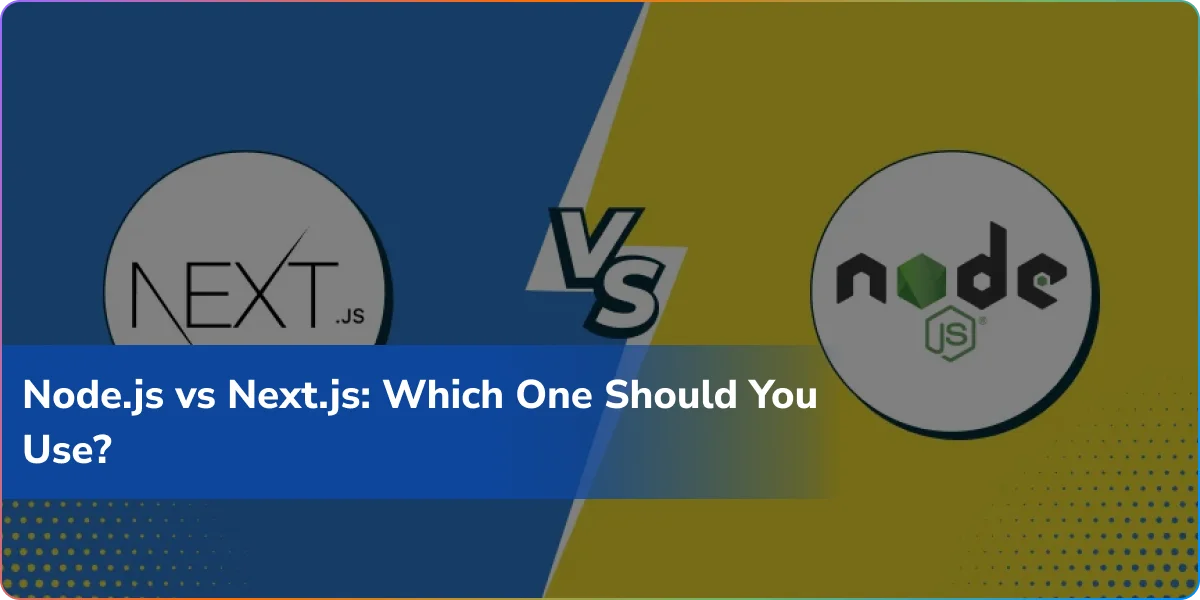Ever wonder what drives today’s web apps to be so dynamic, responsive, and user-focused? The magic is often in two powerful JS frameworks: React.js and Node.js. From creating a basic website or enterprise system, both these technologies have changed the approach of developers to front-end and back-end development.
But when it comes to Node.js and React.js, what actually separates them? Node js is front end or backend? And what are the best cases to use for each? All your questions will be answered by this in-depth guide and aid you in selecting the best for your web development project.
Introduction to Node.js and React.js
Let’s learn what is React js and node js to have a clear idea about each:
Understanding React.js
React.js is an open source JavaScript library for creating interactive and dynamic user interfaces (UI) by Facebook. It is client-side focused, dealing with what is displayed and responded to by a site visitor or app user.
React eases the work of developers in building reusable UI components that speed up the app, make it efficient, and maintainable. Its component-based architecture also makes the work of developers easier in building scalable single-page applications (SPAs).
In short, React speeds up web apps, modularizes, and makes them user-friendly.
Node.js: A Brief Insight
Node.js is a cross-platform, open-source runtime environment that allows developers to run JavaScript outside the browser. Essentially, it allows you to apply JavaScript for server-side development.
If you ever thought, “Node js is front end or backend?”, then the response is obvious: Node.js is a backend. It allows developers to create speedy, scalable, and efficient server-side applications based on JS frameworks, without having a standalone backend language like PHP or Python.
What does Node js do?
- Developing server-side applications
- Developing RESTful APIs
- Creating real-time apps such as chat applications
- Executing microservices and backend code
- Database management
Node.js enables full-stack JavaScript development, i.e., the same language is employed to create client-side and server-side code.
React js and Node js: The Ultimate Pair
Although they serve different purposes, React.js and Node.js often go hand in hand to deliver full web applications.
- React.js handles the front end, displaying data, managing the user interface, and ensuring smooth interactivity.
- Node.js manages the backend, handling storage of data, server logic, and database interaction
e-commerce website example:
- React.js would manage the product display, cart management, and checkout page.
- Node.js would execute the commands, manage authentication, and interact with the payment gateway.
This tight integration of Node.js and React.js is a highly effective combination for full-stack JavaScript development.
Key Difference Between Node js and React js
Let us find the difference between Node js and React js on some of the key aspects:
| Aspect | Node.js | React.js |
| Type | Runtime environment | JavaScript library |
| Developed By | Ryan Dahl (2009) | Facebook (2013) |
| Purpose | Backend development | Frontend development |
| Language Used | JavaScript (runs on server) | JavaScript (runs on the browser) |
| Execution | Executes JS code on the server | Renders UI components in the browser |
| Use Case | APIs, real-time apps, servers | UI, SPAs, dashboards |
| Framework Examples | Express.js, Nest.js | Next.js, Gatsby.js |
| Performance | Handles multiple client requests efficiently | Improves UI rendering and DOM updates |
| Rendering | Server-side | Client-side (with option for SSR via Next.js) |
Best Use Cases of Node.js for Web Development
To understand what is Node js used for, let us look at real applications where Node really excels:
Real-Time Applications: It is best for chat applications, live updates, or streaming sites due to its event-driven model and non-blocking I/O.
API Development:Node.js is used by developers to create lightweight, fast, and scalable APIs. Express.js makes it simple to create RESTful services.
E-commerce Platforms: Successfully dealing with dozens of requests at the same time makes Node a great fit for e-commerce sites.
Microservices Architecture:Node.js is a good fit for modular development, which is perfect for large-scale microservices applications.
IoT Applications:Due to its async processing, Node.js is capable of processing enormous data from IoT devices in real-time.
Use Cases of React.js
1. Single-Page Applications (SPAs)
React is ideal for SPAs where content changes dynamically without having to reload pages (e.g., Gmail, Instagram).
2. Dynamic Web Interfaces
Its Virtual DOM enables effortless smooth real-time UI updates.
3. Mobile Applications
With React Native, developers can code mobile apps for Android and iOS from a single React codebase.
4. Dashboards and Data Visualization
React’s component-based approach is ideal to develop interactive dashboards and analytics consoles.
5. Progressive Web Apps (PWAs)
React allows you to build quick, interactive web applications with a native mobile feel.
Node js vs React js: Which One Do You Use?
Node js vs React js is based on what you are going to build.
| Scenario | Recommended Technology |
| Building a real-time chat app or API server | Node.js |
| Creating dynamic and interactive user interfaces | React.js |
| Developing a full-stack JavaScript application | React.js + Node.js |
| Building mobile applications | React.js (React Native) |
| Creating server-side rendered websites | Node.js with Next.js or Express.js |
If your aim is to manage backend logic and handle requests, go for Node.js. But if your aim is to enhance user interaction and interface, then React.js is the best option.
Benefits of Using Both React js and Node js
Both Node.js and React.js allow you to leverage the full potential of JavaScript server and client-side. It is favored by developers due to the following reasons:
Single Language Development:You are able to code backend and front-end in JS frameworks, with no time spent on learning, and better efficiency.
High Performance:Node.js runs backend operations at speed, and React.js enables silky smooth front-end performance.
Scalability:Both technologies are coded with scalability, ideal for startups as well as large businesses.
Fast Development:Modularity of React and lean frameworks of Node.js enable speedy development.
Rich Ecosystem:There are thousands of libraries available in the npm (Node Package Manager) to build React.js and Node.js.
Want to recruit skilled Node.js and React.js developers? Logixbuilt Solutions provides scalable full-stack JS frameworks for contemporary web applications
Node.js and React.js in Real-World Applications
A few of the world’s best-known platforms are built upon React js and Node js:
- Netflix utilizes Node.js for fast server-side rendering and React for user interfaces.
- Uber utilizes Node.js for real-time data processing.
- React.js is utilized by Instagram for dynamic front-end rendering.
- Node.js is utilized by LinkedIn and PayPal to enhance performance and scalability.
These are all examples of how both technologies go along well together to deliver top web experiences.
Conclusion
We can now say that while contrasting Node.js vs React.js, it’s not about one being superior to the other; it’s about knowing their function.
If you are developing new web applications, utilizing React.js and Node.js as a combination provides the ideal full-stack solution, robust, efficient, and easy to scale.
Our team at Logixbuilt Solutions is expert in developing high-performance web applications with the latest JS Frameworks such as React.js and Node.js.
Be it startups who desire to create their MVP or large businesses who want to scale their online operations, our skilled developers deliver speed, scalability, and seamless user experiences.
FAQ’s
1.What is the primary distinction between Node js and React js?
The primary distinction between node js and react js is the application: Node.js on the backend, React.js for frontend development. Node.js executes JavaScript on the server, while React is applied for dynamic user interface building on the client side.
2. Node js is front end or backend?
It is a server-side. It enables developers to run JavaScript on the server, handle APIs, talk to databases, and create scalable server-side applications in an efficient manner.
3. Are React js and Node js compatible?
Yes! React takes care of the user interface, while Node handles backend operations and data transmission, and they are a great combination for full-stack web development.
4. What is node js used for in web development?
It is mainly used for the construction of server-side applications, RESTful APIs, real-time chat applications, and microservices. It’s also famous for its event-driven architecture and scalable speed.
5. Why should I opt for Logixbuilt Solutions for my React.js or Node.js project?
We have JS frameworks certified experts here at Logixbuilt Solutions who specialize in React.js and Node.js. We combine technical expertise, creative UI/UX, and agile development principles to provide scalable, efficient, and custom-designed solutions to meet your business requirements.



